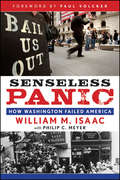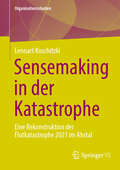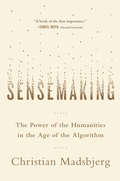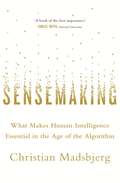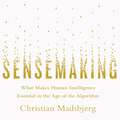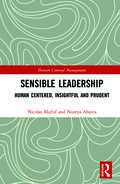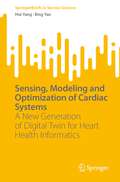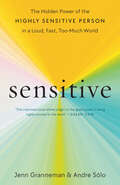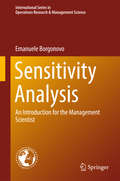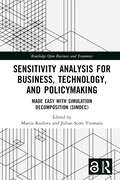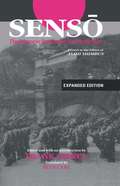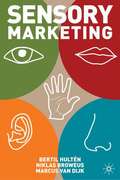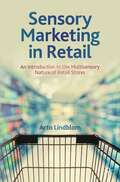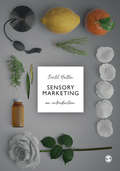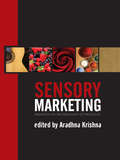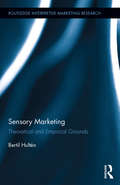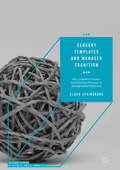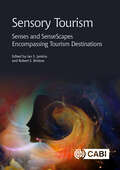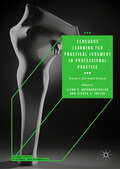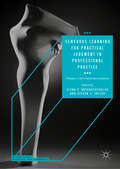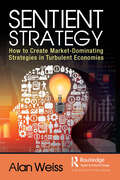- Table View
- List View
Senseless Panic: How Washington Failed America
by William M. IsaacThe 1980s opened with the prime interest rate at an astonishing 21.5 percent, leading to a severe recession with unemployment reaching nearly 11 percent. Depression-like conditions befell the agricultural sector, a bubble burst in the energy sector, a rolling real estate recession swept the country, the entire thrift industry was badly insolvent and the major money center banks were loaded with third world debt. Some 3,000 bank and thrifts failed, including nine of Texas’ 10 largest, and Continental Illinois, which, at the time, was the 7thlargest bank in the nation. These severe conditions were not only handled without creating a panic, the economy actually embarked on the longest peacetime expansion in history. In Senseless Panic: How Washington Failed America, William M. Isaac, Chairman of the Federal Deposit Insurance Corporation (FDIC) during the banking and S&L crises of the 1980s, details what was different about 2008’s meltdown that allowed the failure of a comparative handful of institutions to nearly shut down the world’s financial system. The book also tells the rousing story of Isaac’s time at the FDIC. With accessible and engaging prose, Isaac: Details the mistakes that led to the panic of 2008 and 2009 Demystifies the conditions America faced in 2008, and Provides a roadmap for avoiding similar shutdowns and panics in the future Senseless Panicis a provocative, quick-paced, and thoughtful analysis of what went wrong with the nation's banking system and a blunt indictment of United States policy.
Sensemaking in der Katastrophe: Eine Rekonstruktion der Flutkatastrophe 2021 im Ahrtal (Organisationsstudien)
by Lennart KoschitzkiDieses Buch bietet eine soziologische Perspektive auf die Flutkatastrophe 2021 im Ahrtal – und zeigt damit Strukturen und Bedingungen auf, welche im Hintergrund der Flutnacht zu ihren tragischen Ausmaßen führten. Nach Desastern steht oft die Frage im Raum, wie es trotz nachweislich vorliegender Warnsignale zu einer derartigen Eskalation kommen konnte. Auch nach der Flut im Kreis Ahrweiler erscheinen die Fehlentscheidungen bei den Verantwortlichen nicht nachvollziehbar. In diesem Buch wird zur Beleuchtung dieser Rätsel ein anderer Blickwinkel vorgeschlagen: Das kritischste Element der Flutkatastrophe und deren missglückter Bewältigung lag nicht in Fehlentscheidungen, sondern in den zugrundeliegenden Fehleinschätzungen. Unter Zuhilfenahme von „Sensemaking“ nach Karl E. Weick werden diese Fehleinschätzungen vom 14. und 15. Juli 2021 in ihren Kontexten sicht- und greifbar gemacht. Neben dem fokussierten Krisenstab in Bad Neuenahr-Ahrweiler werden auch weitere zentrale Akteure und widrige Gegebenheiten dieses Zusammenhangs untersucht. Darüber hinaus werden organisationale Einflussfaktoren der Flutkatastrophe herausgestellt; denn wie bei allen Katastrophen bildete sie sich aus dem Zusammenspiel mehrerer, teils völlig voneinander unabhängiger Aspekte. Für das ergänzende Verständnis wird neben einer einführenden Rekonstruktion des Katastrophenhergangs auch eine Einordnung von Krisenstäben als organisationaler Sonderform im hier betrachteten Sinne geboten. Daraus ergibt sich die Gelegenheit, aus den Geschehnissen im Kreis Ahrweiler zu lernen. Damit bietet dieses Buch insbesondere für Katastrophenforscher und Katastrophenschützer Impulse und Lektionen.
Sensemaking: The Power of the Humanities in the Age of the Algorithm
by Christian MadsbjergBased on his work at some of the world's largest companies, including Ford, Adidas, and Chanel, Christian Madsbjerg's Sensemaking is a provocative stand against the tyranny of big data and scientism, and an urgent, overdue defense of human intelligence. Humans have become subservient to algorithms. Every day brings a new Moneyball fix--a math whiz who will crack open an industry with clean fact-based analysis rather than human intuition and experience. As a result, we have stopped thinking. Machines do it for us. Christian Madsbjerg argues that our fixation with data often masks stunning deficiencies, and the risks for humankind are enormous. Blind devotion to number crunching imperils our businesses, our educations, our governments, and our life savings. Too many companies have lost touch with the humanity of their customers, while marginalizing workers with liberal arts-based skills. Contrary to popular thinking, Madsbjerg shows how many of today's biggest success stories stem not from "quant" thinking but from deep, nuanced engagement with culture, language, and history. He calls his method sensemaking. In this landmark book, Madsbjerg lays out five principles for how business leaders, entrepreneurs, and individuals can use it to solve their thorniest problems. He profiles companies using sensemaking to connect with new customers, and takes readers inside the work process of sensemaking "connoisseurs" like investor George Soros, architect Bjarke Ingels, and others. Both practical and philosophical, Sensemaking is a powerful rejoinder to corporate groupthink and an indispensable resource for leaders and innovators who want to stand out from the pack.
Sensemaking: What Makes Human Intelligence Essential in the Age of the Algorithm
by Christian MadsbjergA FINANCIAL TIMES BUSINESS BOOK OF THE MONTH (APRIL 2017)Humans have become subservient to algorithms. Every day brings a new Moneyball fix - a maths whiz who will crack open an industry with clean fact-based analysis rather than human intuition and experience. As a result, we have stopped thinking. Machines do it for us. Christian Madsbjerg argues that our fixation with data often masks stunning deficiencies, and the risks for humankind are enormous. Blind devotion to number crunching imperils our businesses, our educations, our governments, and our life savings. Too many companies have lost touch with the humanity of their customers, while marginalising workers with arts-based skills. Contrary to popular thinking, Madsbjerg shows how many of today's biggest success stories stem not from 'quant' thinking but from deep, nuanced engagement with culture, language, and history. He calls his method sensemaking. In this landmark book, Madsbjerg lays out five principles for how business leaders, entrepreneurs, and individuals can use it to solve their thorniest problems. He profiles companies using sensemaking to connect with new customers, and takes readers inside the work process of sensemaking 'connoisseurs' like investor George Soros, architect Bjarke Ingels, and others. Both practical and philosophical, Sensemaking is a powerful rejoinder to corporate groupthink and an indispensable resource for leaders and innovators who want to stand out from the pack.
Sensemaking: What Makes Human Intelligence Essential in the Age of the Algorithm
by Christian MadsbjergA FINANCIAL TIMES BUSINESS BOOK OF THE MONTH (APRIL 2017)Humans have become subservient to algorithms. Every day brings a new Moneyball fix - a maths whiz who will crack open an industry with clean fact-based analysis rather than human intuition and experience. As a result, we have stopped thinking. Machines do it for us. Christian Madsbjerg argues that our fixation with data often masks stunning deficiencies, and the risks for humankind are enormous. Blind devotion to number crunching imperils our businesses, our educations, our governments, and our life savings. Too many companies have lost touch with the humanity of their customers, while marginalising workers with arts-based skills. Contrary to popular thinking, Madsbjerg shows how many of today's biggest success stories stem not from 'quant' thinking but from deep, nuanced engagement with culture, language, and history. He calls his method sensemaking. In this landmark book, Madsbjerg lays out five principles for how business leaders, entrepreneurs, and individuals can use it to solve their thorniest problems. He profiles companies using sensemaking to connect with new customers, and takes readers inside the work process of sensemaking 'connoisseurs' like investor George Soros, architect Bjarke Ingels, and others. Both practical and philosophical, Sensemaking is a powerful rejoinder to corporate groupthink and an indispensable resource for leaders and innovators who want to stand out from the pack.
Sensible Leadership: Human Centered, Insightful and Prudent (Human Centered Management)
by Nicolas Majluf Nureya AbarcaThis Leadership book is part of the Human Centered Book Trilogy, the 2021 volumes of the Routledge Human Centered Management HCM Series. HCM books are pioneering transformation from the traditional humans-as-a-resource approach of the industrial past, to the humans at the center management and organizational paradigm of the 21st century. HCM is built on the talent and wellbeing of people in the workplace driving work engagement, quality standards, high performance and productivity for long-term organizational sustainability in the global VUCA (volatile, uncertain, complex, ambiguous) environment. This book was carefully crafted by recognized human centered scholars emphasizing the need for a new type of leader responsive to challenges of the knowledge age, global connectivity and instant communications. The book displays a comprehensive framework for the transformation of common individuals into sensible leaders with high capacity to improve organizational culture using Soft Skills to meet critical responsibilities. Sensible leaders are human centered, insightful, prudent, focused on the needs and feelings of followers. They are integral and ethical leaders serving as guides, coaches and mentors, not forcing followers but perceiving clues and responding promptly to solve organizational challenges. They perform honorably in personal and work environments always caring for the common good. This and its two complementary titles Human Centered Organizational Culture: Global Dimensions and Soft Skills for Human Centered Management and Global Sustainability are timely readings for leaders, managers, researchers, acdemics, practitiones, students and the general public working in organizations across industries and sectors wordwide pursuing quality standards, organizational transformation and sustainability.
Sensing (and Monetizing) Happiness at Hitachi
by Ethan S. Bernstein Stephanie MartonInspired by research linking happiness and productivity, Hitachi had invested in developing new "people analytics" technologies to help companies increase employee happiness. Hitachi had begun manufacturing high-tech badges that quantify a wearer's activity patterns. Data from these devices revealed an unusually high correlation between certain patterns of activity and a person's subjective sense of happiness at work. Unlike mood rings or even facial expressions, both of which were highly unreliable, Dr. Kazuo Yano--the mastermind responsible for bringing ""happiness sensors"" to market--believed he now had the ability to accurately sense happiness. When combined with other sources of data like Outlook calendars or email, Dr. Yano's team could pinpoint with scientific precision which activities, events, or even people generated the most happiness in employees at work. With a firm proof of concept in hand, Dr. Yano was ready to push the business model further. He was rolling out an app to provide personalized "happiness" recommendations to employees, and he was considering other ways to automate the model to bring it to scale. He was confident that the new technology had the power to transform employee happiness and the productivity of workforces, in Japan and beyond, if he could only find the right business model to launch such a happiness movement.
Sensing, Modeling and Optimization of Cardiac Systems: A New Generation of Digital Twin for Heart Health Informatics (SpringerBriefs in Service Science)
by Hui Yang Bing YaoThis book reviews the development of physics-based modeling and sensor-based data fusion for optimizing medical decision making in connection with spatiotemporal cardiovascular disease processes. To improve cardiac care services and patients’ quality of life, it is very important to detect heart diseases early and optimize medical decision making. This book introduces recent research advances in machine learning, physics-based modeling, and simulation optimization to fully exploit medical data and promote the data-driven and simulation-guided diagnosis and treatment of heart disease. Specifically, it focuses on three major topics: computer modeling of cardiovascular systems, physiological signal processing for disease diagnostics and prognostics, and simulation optimization in medical decision making. It provides a comprehensive overview of recent advances in personalized cardiac modeling by integrating physics-based knowledge of the cardiovascular system with machine learning and multi-source medical data. It also discusses the state-of-the-art in electrocardiogram (ECG) signal processing for the identification of disease-altered cardiac dynamics. Lastly, it introduces readers to the early steps of optimal decision making based on the integration of sensor-based learning and simulation optimization in the context of cardiac surgeries. This book will be of interest to researchers and scholars in the fields of biomedical engineering, systems engineering and operations research, as well as professionals working in the medical sciences.
Sensitive: The Hidden Power of the Highly Sensitive Person in a Loud, Fast, Too-Much World
by Jenn Granneman Andre Sólo&“This important book reframes the way we think about sensitivity—our own or someone else&’s—and shines a light on the great power in being highly attuned to the world.&”—Susan Cain, #1 New York Times bestselling author of Bittersweet and QuietA paradigm-shifting look at a long-undervalued yet hugely beneficial personality trait, from the creators of the world&’s largest community for highly sensitive people &“Don&’t be so sensitive!&”Everyone has a sensitive side, but nearly one in three people have the genes to be more sensitive than others—both physically and emotionally. These are the people who pause before speaking and think before acting; they tune in to subtle details and make connections that others miss. Whether introverted or extroverted, they tend to be bighearted, creative, and wired to go deep, yet society tells them to hide the very sensitivity that makes them this way. These are the world&’s &“highly sensitive people,&” and Sensitive is the book that champions them.From the creators of the world&’s largest community for sensitive people, Sensitive teaches us how to unlock the potential in this undervalued strength and leverage it across the most important areas of our lives: friendships and intimate relationships, the workplace, leadership, and parenting. Through fascinating research and expert storytelling, Jenn Granneman and Andre Sólo—sensitive people themselves—show us that the way to thrive as a sensitive person is not to hide our sensitivity but to embrace it, and how to do that in every area of life. Weaving together actionable advice, relatable anecdotes, and the latest scientific research, Granneman and Sólo demonstrate how leaning into sensitivity unlocks a powerful boost effect to propel us ahead in life. They hand us the tools and insights we need to thrive as sensitive people in a loud, fast, too-much world.A powerfully validating, destigmatizing, and practical book, Sensitive plants a gently fluttering flag in the ground for sensitive people everywhere. This inspiring book has the power to change, once and for all, how we see sensitive people—and how they see themselves.
Sensitivity Analysis
by Emanuele BorgonovoThis book is an expository introduction to the methodology of sensitivity analysis of model output. It is primarily intended for investigators, students and researchers that are familiar with mathematical models but are less familiar with the techniques for performing their sensitivity analysis. A variety of sensitivity methods have been developed over the years. This monograph helps the analyst in her/his first exploration of this world. The main goal of is to foster the recognition of the crucial role of sensitivity analysis methods as the techniques that allow us to gain insights from quantitative models. Also, exercising rigor in performing sensitivity analysis becomes increasingly relevant both to decision makers and modelers. The book helps the analyst in structuring her/his sensitivity analysis quest properly, so that to obtain the correct answer to the corresponding managerial question. The first part of the book covers Deterministic Methods, including Tornado Diagrams; One-Way Sensitivity Analysis; Differentiation-Based Methods and Local Sensitivity Analysis with Constraints. The second part looks at Probabilistic Methods, including Regression-based methods, Variance-Based Methods, and Distribution-based methods. The final section looks at Applications, including capital budgeting, sensitivity analysis in climate change modelling and in the risk assessment of a lunar space mission.
Sensitivity Analysis for Business, Technology, and Policymaking: Made Easy with Simulation Decomposition (SimDec) (Routledge Open Business and Economics)
by Mariia Kozlova Julian Scott YeomansSimDec is a revolution in decision-making support. SimDec “teases out” inherent cause-and-effect relationships and reveals the intricacy of relationships between sets of input and output variables. At its core, SimDec is an amalgamation of uncertainty and global sensitivity analysis with an innovative visualization technique. While straightforward and elegant, this novel approach significantly enhances the analytical capabilities of users by readily exposing seemingly, a priori, counterintuitive behaviours so that they can be readily understood by both technical specialists and non-technical users alike.This book is the first to articulate the ubiquitous applicability of SimDec and has been written by the leading proponents of the technique. The book provides the necessary background to fully understand the underlying approach and then demonstrates its applicability to a wide spectrum of fields, such as finance, entrepreneurship, energy, 3D manufacturing, geology, the environment, engineering, public policy, and even superconducting magnets. To facilitate as widespread adoption and penetration of SimDec as possible, all supporting computer codes are available, open-source, in Python, Julia, R, and Matlab.The innovative material will be of primary benefit to practitioners and researchers analyzing data from the social sciences, business, science, engineering, mathematics, and computing.The Open Access version of this book, available at http://www.taylorfrancis.com, has been made available under a Creative Commons [Attribution-Non Commercial-No Derivatives (CC-BY-NC-ND)] 4.0 license.
Senso: Letters to the Editor of "Asahi Shimbun"
by Frank Gibney Beth CaryThis acclaimed work is an extraordinary collection of letters written by a wide cross-section of Japanese citizens to one of Japan's leading newspapers, expressing their personal reminiscences and opinions of the Pacific war. "SENSO" provides the general reader and the specialist with moving, disturbing, startling insights on a subject deliberately swept under the rug, both by Japan's citizenry and its government. It is an invaluable index of Japanese public opinion about the war.
Sensormatic Electronics Corp.
by David A. GarvinDescribes the decision faced by a rapidly growing firm in the merchandise security systems business on whether it should integrate backward into the injection molding of plastic parts. Financial analysis, comparative economics, and manufacturing strategy in an industry with rapid technological change are all important elements in the analysis.
Sensory Marketing
by Bertil Hultén Niklas Broweus Marcus Van DijkThe book covers the ongoing shift from mass-marketing and micro-marketing to sensory marketing in terms of the increased individualization in the contemporary society. It shows the importance in reaching the individuals' five senses at a deeper level than traditional marketing theories do.
Sensory Marketing in Retail: An Introduction to the Multisensory Nature of Retail Stores
by Arto LindblomSensory marketing is a way to differentiate businesses from their competition while influencing customers and their behaviour. At its best, sensory marketing guides or helps customers to make certain choices in a way that they are unaware of what actually influenced their choices. Although it sounds like an attractive way to “nudge” customers, it is a highly demanding practice that also involves risks and ethical concerns. This textbook delves into the world of sensory marketing in a physical retail setting and offers a comprehensive and coherent view of various sensory cues and their capacity to drive our behaviour through stimulating our senses and creating sensory experiences. It particularly highlights the meaning of the multisensory nature of retail stores and emphasises how cues tend to affect us in combination rather than separately as single cues. After reading this book, you will be able to: · Identify various cues in a retailing setting · Categorise cues into different groups · Explain how cues affect consumers when they make their daily choices · Understand the multisensory nature of retail stores and the meaning of cue (in)congruence · Describe how consumers are likely to respond differently to cue combinations than single cues · Apply cues in practice and assess their outcomes. Ideal reading for students taking classes in consumer behaviour, shopper marketing, retail marketing and store design among others, it contains more than 30 global examples from various retail companies, self-reflective questions and decisions-based questions to aid learning.
Sensory Marketing: An Introduction
by Bertil HultenAuthored by Bertil Hultén, one of the world′s leading professors of sensory marketing, this text brilliantly explains the techniques through which a sensory experience can be created to surround a consumer. Sensory experiences combine not only to increase the chance of an immediate sale, but to influence perception of a product which then plays into a customer′s chance of return, and brand loyalty for the future. • Hulten provides definitions, insight boxes, questions and case studies to provide an engaging learning experience. • The author is one of the most published professors in the field, sharing exclusive expertise and experience. • The book is thorough yet accessible, dedicating a chapter to each of the 5 senses.
Sensory Marketing: An Introduction
by Bertil HultenAuthored by Bertil Hultén, one of the world′s leading professors of sensory marketing, this text brilliantly explains the techniques through which a sensory experience can be created to surround a consumer. Sensory experiences combine not only to increase the chance of an immediate sale, but to influence perception of a product which then plays into a customer′s chance of return, and brand loyalty for the future. • Hulten provides definitions, insight boxes, questions and case studies to provide an engaging learning experience. • The author is one of the most published professors in the field, sharing exclusive expertise and experience. • The book is thorough yet accessible, dedicating a chapter to each of the 5 senses.
Sensory Marketing: Research on the Sensuality of Products
by Aradhna KrishnaWhat is sensory marketing and why is it interesting and also important? Krishna defines it as "marketing that engages the consumers’ senses and affects their behaviors." In this edited book, the authors discuss how sensory aspects of products, i.e., the touch , taste, smell, sound, and look of the products, affect our emotions, memories, perceptions, preferences, choices, and consumption of these products. We see how creating new sensations or merely emphasizing or bringing attention to existing sensations can increase a product’s or service’s appeal. The book provides an overview of sensory marketing research that has taken place thus far. It should facilitate sensory marketing by practitioners and also can be used for research or in academic classrooms.
Sensory Marketing: Theoretical and Empirical Grounds (Routledge Interpretive Marketing Research)
by Bertil HulténSensory Marketing offers a global view of the use of senses in marketing strategy based on consumers' perception and behaviour. Integrating the company constraints and classical approaches of branding and communication, the author presents sensory marketing as an emergent marketing paradigm in theory and practice. This book will be an important contribution that will provide useful reading for marketing scholars and consumer psychologists across the world.
Sensory Templates and Manager Cognition: Art, Cognitive Science And Spiritual Practices In Management Education (Palgrave Studies In Business, Arts And Humanities Ser.)
by Claus SpringborgThis book explores the role of art and spiritual practices in management education. It takes recent developments in cognitive science relating to the metaphorical and embodied nature of cognition as its starting point. Introducing the concept of ‘sensory templates’, Springborg demonstrates how managers unconsciously understand organizational situations and actions as analogous to concrete sensorimotor experiences, such as pushing, pulling, balancing, lifting, moving with friction, connecting and moving various substances. Real-life management and leadership case studies illustrate how changing the sensory templates one uses to understand a particular situation can increase managerial efficiency and bring simple solutions to problems that have troubled managers for years. Sensory Templates and Manager Cognition will be of interest to scholars and students of managerial cognition, leadership and neuroscience, as well as practising managers and management educators.
Sensory Tourism: Senses and SenseScapes Encompassing Tourism Destinations
by Carlos Ferreira Karen Davies Rubén C. Lois-González Gunnar Thór Jóhannesson Professor Katrín Anna Lund Carla Fraga Elisa Alén González Philip Stone Tim Taylor Trinidad Domínguez Vila Kathryn Terzano Émilie Crossley Hilary Becker Sara Duerte Prof. Dr. Hairul Nizam Ismail Sofie Scheen Jahnsen Claudette John Margaret Kenna Jaciel Gustavo Kunz Sharanya M Chandru M C Dr Velvet Nelson Dr Nur Haizum Rahman Breixo Martins Rodal Carlos Alberto Romarís Lucia Rubio Bidisha Sarkar Dr Deborah Slater Patricia A. Stokowski Dr Pola Wang Dr Aristeidis Gkoumas Dr Nur Hidayah RahmanTourism offers countless global locations, providing a multitude of sensory experiences. These include commercialised tourism products such as saunas and floatation tanks through to natural phenomenon such as mountains and wilderness destinations. Consequently, sensory elements are a curious concept within tourism because every destination provides a sensory experience of one kind or another. The first of its kind, this book examines holidays and tourism through sensory perceptions which either encourage or deter consumers. It studies sensoryscapes and how they effect and affect tourism at destinations and be linked with the development of tourist niches, reflecting the segmenting of the mass market tourism into smaller segments. Finally, it reflects on how with increased urbanisation there a growing need is to find quiet spaces, free from urban or anthropogenic noise, such as silent retreats and dark sky meditation holidays. Escape has always been one of the main components of tourism development together with attraction to spatial locations that match tourists' needs. Structed to address each of the senses separately, this book provides a: · wide range of case studies from interdisciplinary backgrounds · links amongst common themes across the various threads of research on sensory experiences · theoretical framework and practical application for sensory tourism. It will be of interest to those studying tourism management as well as wider social science disciplines.
Sensuous Learning for Practical Judgment in Professional Practice: Volume 1: Arts-based Methods (Palgrave Studies in Business, Arts and Humanities)
by Steven S. Taylor Elena P. AntonacopoulouThe first volume of this ground-breaking book critically examines how and why arts-based methods such as choir conducting workshops and dialogue improvisation can make a difference in improving professional practice. Taking a ‘human-centred’ approach, it delivers an insightful account of what these approaches do differently to achieve a new mode of learning – ‘sensuous learning’ – that cultivates professional judgment to serve the common good, simultaneously supporting personal and collective growth. The chapters present cutting edge examples of multiple ways arts-based methods underpin learning arenas for expanding leadership and improving professional practice. The reflexivity cultivated through these learning arenas has the unique potential to improve professional practice, not merely by enhancing competence but also by cultivating character and conscience, which is central in making judgments that serve the common good. These benefits are relevant for professional practitioners sharpening the skills and behaviours needed in organisations, including creativity, diversity, imagination, and improvisation.
Sensuous Learning for Practical Judgment in Professional Practice: Volume 2: Arts-based Interventions (Palgrave Studies in Business, Arts and Humanities)
by Steven S. Taylor Elena P. AntonacopoulouThe second volume of this ground-breaking book critically examines the effect of arts-based methods in combination as arts-based interventions in improving professional practice, from deinstitutionalization to the counteraction of destructive leadership. Taking a ‘human-centred’ approach, it delivers an insightful account of what these approaches do differently to achieve a new mode of learning – ‘sensuous learning’ – that cultivates professional judgment to serve the common good, simultaneously supporting personal and collective growth. The chapters present cutting edge examples of multiple ways arts-based interventions underpin learning arenas for expanding leadership and improving professional practice. The reflexivity cultivated through these learning arenas has the unique potential to improve professional practice, not merely by enhancing competence but also by cultivating character and conscience, which is central in making judgments that serve the common good. These benefits are relevant for professional practitioners sharpening the skills and behaviours needed in organisations, including creativity, diversity, imagination, and improvisation.
Sentient Jet: The Uber of Private Jets
by Anat Keinan Sandrine CrenerFounded in 1999 in the Boston area, Sentient Jet had become a leading private aviation company in the United States. Its success was built on the introduction of a groundbreaking membership program that offered business travelers the flexibility and convenience of flying private aircraft for their personal and business needs at an outstanding and unparalleled value. Sentient functioned differently and more efficiently than traditional charter companies: it used an open fleet model, renting jets from a pool of certified charter companies. Thanks to its innovative business model and proprietary technology platform, the firm was providing its clients with all the benefits of owning a fleet of aircraft with none of the associated costs and commitments. Its fares were typically 20% to 30% lower than those of its competitors. In a nutshell, Sentient Jet had invented the Uber of private jets before Uber even existed. With over 15 years of experience, the company was serving more than 5,000 cardholders, and Andrew Collins, president of Sentient Jet, was considering various strategies to double the company's size in the next few years.
Sentient Strategy: How to Create Market-Dominating Strategies in Turbulent Economies
by Alan WeissNo pre-pandemic strategy is effective anymore. None. Not for organizations large or small, for-profit or non-profit, domestic or global. Claims of a "return to normal" or "the new normal" are ridiculous. What we’re facing is really a "new reality," and that reality is the need for agile strategic decisions and pragmatic views of the future. That means that strategy formulation can be reduced to a few days and the view of the future can only be 12–18 months. This is the antithesis of Peter Drucker’s approach to strategy, but his highly effective approach was developed at GM three quarters of a century ago. It’s time to move on. Alan Weiss has developed an original and completely new approach to strategy which thus far has certified over 100 people globally, delivering this approach to scores of firms of all types in four countries. More than two dozen firms are using this approach. Sentient Strategy is based on two modern dimensions: awareness of the environment in which the organization exists and has influence, and consciousness of the impact of actions being considered. The old SWOT (strengths, weaknesses, opportunities, threats) approaches are currently equivalent to riding down the freeway on a horse. We must drop the hubris that has led us to believe we can see years ahead and anticipate what’s coming. No one predicted the Internet No one predicted the latest pandemic. It’s time to turn volatility and disruption on their heads and use them as offensive weapons in the marketplace instead of trying to protect ourselves from them. Imagine a strategy that an organization can formulate in just a day or so, revisit easily and frequently, and design a series of shorter-term, viable futures. "Sentient" means "perceptive" and "self-aware." It doesn’t mean "one size fits all" from a cookie-cutter firm’s approach to strategy. Alan Weiss equips the reader to consider using this approach independently. These are new times—a new reality, a "no normal™"—hence, it’s ridiculous to use old approaches to strategy. There’s a clear reason why Sears didn’t morph into Amazon and why Hertz surrendered its number one spot to Enterprise.
